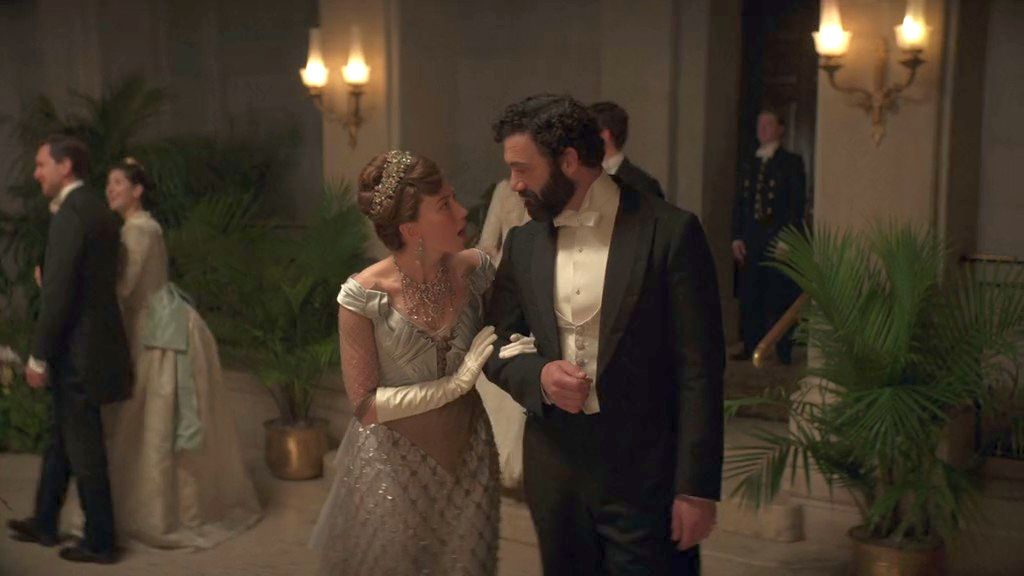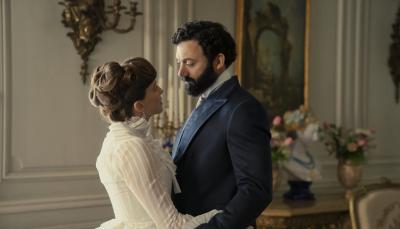Carrie Coon’s Costume Corner: “His Grace the Duke”

Ben Lamb as The Duke, Carrie Coon as Bertha Russell in 'The Gilded Age' Season 2
Barbara Nitke/HBO
Welcome back to Carrie Coon’s Costume Corner, our Gilded Age column covering exclusively Carrie Coon’s costumes in her role as the beautiful and socially ambitious nouveau riche matron Bertha Russell. Series costume designer Kasia Walicka Maimone’s costumes for other characters are fascinating and worthy of conversation, but Bertha’s gowns are more adventurous, more exuberant, more statement-making, more everything.
Bertha wears five dresses in “His Grace The Duke,” and two of them are so impressive that it was quite a challenge to choose between them so that one Gown of the Week could rule them all; however, in the end, the award went to Elevated Pewter and Bronze.
At first, I thought this dress was a celebration of silver and gold, and that was awesome because who cares about not mixing precious metals? After rewinding and pausing many times to catalog details of Bertha’s gown when she and George (now happily reconciled) attend a reception welcoming the Duke of Buckingham, I would describe it as a celebration of elevated pewter and bronze. If that sounds like an insult, as if Bertha broke out her second-best silver for guests she doesn’t think much of, please think again.
The bodice is a gray-blue silk with a very wide V-neck, all the better to create space for Bertha’s enormous and ornate bib diamond necklace. She’s also wearing large, squarish diamond drop earrings and a pearl-and-gold headband.
Gown of the Week: Elevated Pewter and Bronze
The bodice is color-blocked, with the blue fabric ending right at the natural waist in a horizontal line, where a golden shantung takes the lead, coming to a point in the Basque waistline she favors so often.
The sleeves are my favorite element of this gown, in part because they’re subtle enough to miss entirely at a distance but, up close, subtly mirror the palette of the rest of the dress. Bertha’s sleeves are elbow-length and are fashioned in illusion (that sheer mesh fabric you see all the time in ice skating and ice dancing costumes) with small, glinting crystals affixed in a diamond pattern. This cleverly echoes the overall woven-in diamond pattern on the skirt, which is the same shade of blue as the top of the bodice. Here, the overall diamond pattern is achieved with sequins and metallic thread.
The bustle is playful but not over the top, constructed of tiered fabric at 30-degree angles to one another, which makes them look like very fancy oversized mermaid scales. A triumph, as befits how well Bertha turns this event to her own purposes.
First Runner-Up: A Living Corinthian Column
Back to the beginning of the episode! Bertha’s first look made me gasp and then wonder aloud to the furniture in my otherwise-empty living room, “Did Bertha Russell just invent gowns with attached shoulder capes?!” Reader, she may have. The palette is once again a white background with midnight blue details, and with the exception of the capes at each shoulder, the design is pretty simple. Midnight blue tape lace is appliquéd to the white fabric in bold verticals, lending the piece a hint of classical Greek architecture. Bertha looks like a Corinthian column come to life as she very proudly leads a tour of the nearly complete Metropolitan Opera House.
The skirt silhouette is strikingly simple, which suits the look as a whole. There are no ruffles in the front and scarcely any extra volume anywhere but the bustle, which itself is pretty small. The bustle features smocking and lots of gathers, but it’s a softer and quieter approach altogether, which lets us focus on the front of the dress and the drama of those cape sleeves.
Honorable Mentions
Conservative Cosplay
Bertha’s second gown this week is a sibling of the extremely conservative Gracious Luncheon Hostess dress she wore last week to welcome union organizer Mr. Henderson. The palette of the main fabric is the same – a matte black botanical pattern on a slightly shiny dark teal background – but there are some more exuberant tweaks to the way the fabric is used. The neck, shoulders, and top half of the bodice are solid black this time, but the neckline and puff sleeves (a very restrained leg o’mutton) mirror those of the Gracious Luncheon Hostess. The line of the black fabric narrows as it comes down the arm, flowing as a wide stripe to the cuff at her wrist. I can’t quite tell if the black pattern on the teal fabric is appliqué or flocked, but it manages to be both conservative and bold simultaneously, which is a very Bertha Russell vibe. It looks like an appropriately glamorous ancestor to Marc Bolan’s structured satin teal-and-black blazer in this 1972 performance on Top of the Pops.
Impressionistic Vision of a Sundae
Bertha’s third gown this week is an absolute vision of sweetness, an Impressionistic Vision of a Sundae (specifically, a strawberry-and-peach ice cream sundae). The softness of the palette and luxurious sheen of the fabric hides the social maneuvering stiletto she’s tucked away somewhere, though she starts putting it to use almost at once in her conversation with Larry’s highly inappropriate love interest, the youngish widow Mrs. Blaine.
We are back in Bertha’s preferred territory of using contrasting patterns to create bold lines. The two main fabrics of the gown – a luscious pink featuring an oversized leaf pattern in peachy-orange and a simple ivory with piping to match the leaves on the other fabric – work in fascinating counterpoint on the bodice. They create a wide V flanking the ivory central pleats and high neck. The right side of the V is in the pink-and-peach leafy pattern, while the left is in the plain ivory fabric, piped with the brightest shade of peach from the leafy pattern on the opposite side. It suggests the sashes that Suffragists would wear several decades later in support of the 19th Amendment.
The peach-piped ivory appears several more times as neat bands on the wrist-length sleeves just above the elbow and at the waistline, which is draped almost like a cinched kimono, rather than the strongly vertical Basque we’ve seen her wear so often. I’ve described an Asian (or more accurately, Orientalist) influence in some of Bertha’s gowns this season, referring to them as chinoiserie, but that style peaked in the 18th century and, by the late 19th century, would have been, at best a classic style (and at worst, old-fashioned). Any design features incorporating Asian-influenced elements in this period are more likely Japonisme (also called Japonesque), another Western wholesale re-imagining of a specific East Asian culture, which became popular following the forced opening of Japan to trade with Western nations in 1854.
If you’ve seen Topsy-Turvy, you’ll recall that a major exhibition of Japanese art and design in London was the inspiration for Gilbert and Sullivan’s effervescent (and super-Orientalist!) late period operetta The Mikado. This wallpaper is from the mid-1880s, but the inclusion of the Brooklyn Bridge, Niagara Falls, and other “idyllic scenes of American industry, including a depiction of telegraph wires, a lighthouse, and a bustling pier scene with paddleboats” makes me think it would find a happy home on the walls of the Russell home at some point. Thank you for entertaining this corrective bit of historical context; and now, back to the gown!
The skirt is in Bertha’s trademark style, with a cream underskirt featuring wide, slightly soft vertical pleats, topped by a partial overskirt in the pink/peach/cream fabric on the right. When Bertha is seated, the angled hem of the overskirt forms a continuous line with the corresponding angle of the V above the waist. The sleeves are wrist length and slightly puffed at the shoulders, which are in the abstract-leafy print. This leads to wide bands of cream with peach piping just above the elbow, and then finally switching to the ivory fabric from the elbow to the wrist.
Pale Blue Flowers
Bertha’s final gown of the episode is a true rarity, a dress without a hint of asymmetry and nary an overskirt to be seen. The background of the fabric is
Ivory, with very pale blue watercolor-ish florals. The flower petals, which look like something between dewdrops & bluebells, may have been painted onto the fabric, and the feature stems look embroidered.
From neck to hem, the dress’s central panel and its sleeves from elbow to wrist are in a contrasting pale gray-green, with an allover leaves-and-branches motif in darker gray-green. The second fabric is a bit busier visually but is still complementary to the main fabric. Not the most memorable thing Bertha’s ever worn, but still pretty great.









